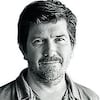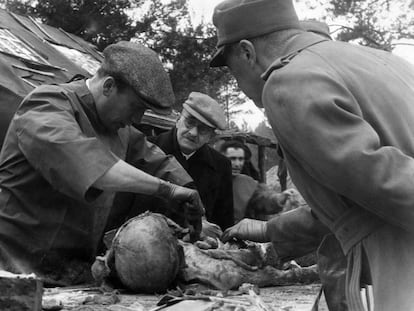Nueva Germania, the Aryan utopia of Nietzsche’s sister and Bernhard Förster in Paraguay
Founded in 1887 in the middle of the Paraguyan wilderness, this town of 6,000 inhabitants is today a reminder of the failure of an anti-Semitic racial experiment

In the middle of the Paraguayan bush, set on red earth and surrounded by vegetation, there is a Lutheran cemetery. On the tombstones are the surnames of the dead: Schütt, Flaskamp, Hähner, Schubert, Haudenschild, Fischer. Carlos Benítez stops in front of one in particular: “Alberto Kück,” reads the inscription on the black marble. Underneath, in brackets, is a nickname: “Pupa.” “He was my friend,” says Benítez. Pupa was the son of a German mother and a Paraguayan father. Like so many other inhabitants of Nueva Germania, he carried in his blood the result of a failure: an Aryan supremacist experiment undertaken in 1870 in this secluded spot in South America by Elisabeth Nietzsche, sister of the German philosopher, and her husband, Bernhard Förster.
Benítez runs a veterinary practice and has lived in Nueva Germania for more than 30 years. He came here for work, fell in love, got married and stayed. With the distance of an outsider, he has reconstructed the history of this town of 6,000 inhabitants. Nietzsche’s sister and Förster “came by boat with a group of Germans interested not only in the land, but also in preserving Aryan culture and ideology.” They had been convinced by a friend, the composer Richard Wagner, who, imbued with the anti-Semitic sentiment of the time, proposed the construction of new Germany far from Europe, close to nature, vegan and, needless to say, without Jews.
To Förster, Paraguay appeared to be an ideal location. “After the War of the Triple Alliance [1864-1869], Paraguay was forced to pay reparations to Brazil and Argentina. The government of Bernardino Caballero sold public land at very low prices. One of the buyers, on credit, was Förster,” says Benítez. A dozen German families seduced by a new life embarked in Hamburg, crossed the Atlantic, traveled up the Paraná River from Argentina and landed on the banks of the Aguaray-Guazú River, almost 300 kilometers (186 miles) northwest of Asunción. Any notion of an Aryan utopia was extinguished as soon as they set foot on land. The hot, humid climate, malaria, parasites, and snakes wreaked havoc among these urban families laden with young children.
“They cut down the bush, made lumber and followed the European tradition of construction,” Benítez says. “But everything became an uphill struggle for them. They thought they were going to come and make money with the yerba mate and wood, but they didn’t have the skills to do it. Some of them adapted and they are the families that are still here now. They didn’t stay because they liked the place; they stayed because they couldn’t go back.”
Among those who had little choice but to remain in Nueva Germania were the Fischers. “My grandmother was four years old when she arrived from Germany on the Föster ship,” says Lidia Fischer, as she folds the freshly laundered clothes of her eight children on a table. She speaks quickly in Spanish peppered with Guaraní, Paraguay’s second official language. “She came with her dad, her mom and four siblings. The youngest died on the trip and was thrown into the sea. My grandmother said they got off somewhere in the bush; they had to survive in any way they could. They had a small vegetable garden and some animals,” she says. Lidia lives with her husband, Hugo Haundeschild, near the house where she was born 49 years ago in a rural area on the outskirts of Nueva Germania.
Fischer and Haundeschild form one of the few families — “no more than 15″ — that have not yet mixed with Paraguayan blood. “My mother did not allow us to speak Guaraní at home and did not want us to mix with another race,” she says. Eventually, the Paraguayan bush ended up colonizing them, out of necessity and circumstance. Haundeschild recalls that he only had two years of schooling in German and that he learned Guaraní “with the farm employees” who worked for his father. “My family didn’t want us to, but we always got together with the workers and learned,” he says. Lidia learned the language at a school for German children where the teacher spoke only Guaraní. They both know that their children will break with the family tradition of marrying only among Germans. “I tell them that if they want to try it, try it. I chose mine and here I am. But if my children tell me: ‘Mom, I’m in love with a Brazilian girl,’ then let them go for it, it’s their life.” She says this with a certain nostalgia, which she tries to stave off by attending the parties organized at the headquarters of the Lutheran church in town.
The building occupies a site where once there also stood a hospital and a large warehouse that provided the supply center of Nueva Germania. Yerba mate was still grown back then, a practice that was lost in the 1980s. The town now makes a living from brick manufacturing, cattle farming, and agriculture. A new, very incipient, industry is arising from tourism. Next to the Lutheran congregation there is a Catholic church. Belonging to one or the other is part of the schism. When the founding families opened up to the Paraguayans, they also changed their religion. In Nueva Germania today there are descendants of the first settlers who are Catholic and know little or nothing of Förster’s anti-Semitic adventure; neither do they know that Nietzsche’s brother-in-law killed himself 10 years after disembarking when he witnessed debts and accusations of embezzlement putting an end to his Aryan dream.
Truck tires whip up a cloud of red dirt in front of Sara Fischer’s store, a half-hour drive from Nueva Germania. Fischer, 51, studied journalism in Asunción and returned to be with her parents. In this dusty environment, Enrique Fischer makes bricks. He has been here since he was born, 76 years ago, to a German father and a Paraguayan mother. He speaks Guaraní, barely understands Spanish and doesn’t know a word of German. “My mother was too Paraguayan, a sergeant,” he says, and his light eyes narrow as he smiles. “Germans are afraid of Paraguayan women, but they love Paraguay’s culture, especially the music and the food. Of my grandfather I have very few memories; of my grandmother I do, because she died at the age of 106,” says Enrique while Sara translates from Guaraní into Spanish.
“I suspect that in Nueva Germania these two cultures merged so deeply that it is already difficult to figure out what is German and what is Paraguayan,” says Sara Fischer. “My German grandfather didn’t speak. He made a tacit deal with my Paraguayan grandmother and he didn’t pass on his culture. That happened in many, many families of German origin. The Paraguayans who were here when Förster arrived taught them the language, the food, how to plant… they passed on everything they had. That is why they were not allowed that feeling of blood superiority; they were warned that they would become meek. My Paraguayan grandmother talked about ‘those blond Indians and we were ‘the brown Indians,’ she says.
Nueva Germania is sparse and silent. The town’s stores are concentrated on the road that leads to Asunción and there are no restaurants; five guest houses cater to the tourists that come, mainly in summer, to fish in the waters of the river that over 150 years ago bore witness to the arrival of Bernhard Förster and his adventurers. A group of children play soccer on a concrete municipal field and the motorcycle workshop is the busiest place. The Virgin of Fátima, the town’s patron saint, is honored on May 13 and the statue has been passed from house to house for nine days. The Rosary is observed, mate is drunk and at the end a game of bingo is held. A museum, currently closed, guards the memory of the first settlers. Traditional German food is hidden in the houses of a few families. “We have to recover our traditions,” says Benítez, “and add in the new ones. Here, we have a nature reserve with alligators just 400 meters from the town square. And a lot of history to tell.”
Elisabeth Nietzsche returned to Germany in 1893, after burying Förster in San Bernardino, a small German colony near Asunción. He had failed in his attempt to bring his brother from Germany to Paraguay: the philosopher detested the anti-Semitic proclamations that had inspired the creation of Nueva Germania. When Friedrich Nietzsche died in 1900, his sister obtained the rights to his manuscripts and rewrote them until she converted her brother into figure in line with her ultranationalist ideas. In 1935, Adolf Hitler and other high-ranking Nazi attended her funeral. Thousands of miles away from Germany, in a Paraguayan town of dusty red streets, there is one named after her: the municipal sign reads “Elizabeth Nigtz Chen.”
Sign up for our weekly newsletter to get more English-language news coverage from EL PAÍS USA Edition
Tu suscripción se está usando en otro dispositivo
¿Quieres añadir otro usuario a tu suscripción?
Si continúas leyendo en este dispositivo, no se podrá leer en el otro.
FlechaTu suscripción se está usando en otro dispositivo y solo puedes acceder a EL PAÍS desde un dispositivo a la vez.
Si quieres compartir tu cuenta, cambia tu suscripción a la modalidad Premium, así podrás añadir otro usuario. Cada uno accederá con su propia cuenta de email, lo que os permitirá personalizar vuestra experiencia en EL PAÍS.
¿Tienes una suscripción de empresa? Accede aquí para contratar más cuentas.
En el caso de no saber quién está usando tu cuenta, te recomendamos cambiar tu contraseña aquí.
Si decides continuar compartiendo tu cuenta, este mensaje se mostrará en tu dispositivo y en el de la otra persona que está usando tu cuenta de forma indefinida, afectando a tu experiencia de lectura. Puedes consultar aquí los términos y condiciones de la suscripción digital.
More information
Archived In
Últimas noticias
Maduro counterattacks Trump with rhetoric and announces downing of nine drug trafficking aircraft
‘Ecce Homo’: The miraculous disaster that made a small Spanish town famous
Return to sex testing at the Olympics: IOC edges closer to banning transgender women
Trump escalates conflict with Venezuela with the start of covert operations
Most viewed
- Sinaloa Cartel war is taking its toll on Los Chapitos
- Oona Chaplin: ‘I told James Cameron that I was living in a treehouse and starting a permaculture project with a friend’
- Reinhard Genzel, Nobel laureate in physics: ‘One-minute videos will never give you the truth’
- Why the price of coffee has skyrocketed: from Brazilian plantations to specialty coffee houses
- Silver prices are going crazy: This is what’s fueling the rally










































